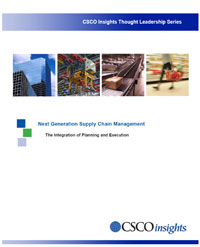However, according to LaHowchic, “Excellence in S&OP is important – but it isn’t enough” to optimally integrate planning and execution.
“Let’s start with the fact than in many companies, S&OP develops because the companies are simply dysfunctional,” LaHowchic said. “S&OP becomes a process where you at least get everyone to play well enough together.”
But, he says, too often the real work is delegated down.
“You have managers working with managers and, in the end, they are in a sense often really making a lot of the decisions,” he added. “But it takes the executive level to change production resources, or re-orient the sales force.” He says that in some companies, the formal S&OP meeting skirts some of the really tough issues that the executive team needs to address.
 He also said that the tactical nature of some S&OP processes will likely have to change – because today there just isn’t enough time in the cycle. He also said that the tactical nature of some S&OP processes will likely have to change – because today there just isn’t enough time in the cycle.
“Companies need to respond much faster tactically,” he said. You can’t wait for a monthly S&OP meeting to make most of those tactical decisions any more.” S&OP will continue to become more strategic, he believes.
LaHowchic also says that retailers have been slow to adopt S&OP.
“The retailers naturally have a merchant mentality,” he says, which sometimes isn’t conducive to the formal disciplines of S&OP. But he says S&OP, by whatever name it might be called in a retailer, is in fact critical to their success today, especially for retailers that have rapidly changing product assortments (apparel, electronics) or that are moving to private label goods in a big way.
Tightening up the Linkages
Market dynamics are also changing the nature of strategic planning and S&OP.
“If you think about strategic planning, it is really becoming more navigational. This is the direction we want to go, but recognizing there will be shifts based on market realities,” he said.
That’s why scenario planning is becoming so essential, he says. In today’s world, no one can well predict the future. Strategy needs to set the overall goal and boundaries, and the degrees of freedom the team has in execution, but how you get there must constantly evolve.
“You don’t assume that you have the right plan, you are assuming it is the wrong plan, and looking how you will respond if things turn out differently,” he said.
He said that too often companies fail to consider, for example, the competitive environment.
“You can have the plan, but it doesn’t get executed in a vacuum,” he said. “You have to understand what is happening competitively against your plan, and make adjustments in the strategy and execution accordingly.”
In the end, integrated supply chain planning is largely about making sure there are tight linkages between those adjustments in strategies and then the tactics and execution processes that should follow.
Our dialog with LaHowchic on integrated planning and execution will continue next week.
Any reaction to LaHowchic’s thoughts? How do you think flatter corporate and supply chain organizations are changing the nature of supply chain work? Are retailers behind in S&OP? Let us know your thoughts at the Feedback button below.
|